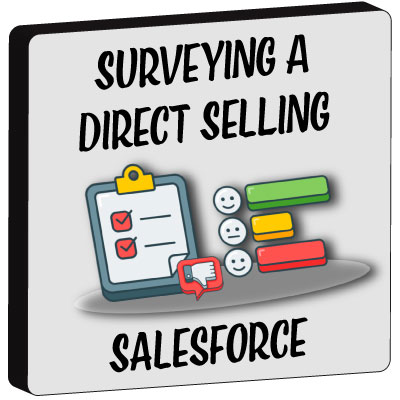 What are they thinking? If you’re not asking this question about your salesforce, you should be!
What are they thinking? If you’re not asking this question about your salesforce, you should be!
While some of your representatives will share their concerns and compliments with you, most won’t. Unsolicited feedback is important, but you shouldn’t rely upon it as your only gauge of field attitudes.
A direct selling business is healthier when its independent representatives have positive attitudes about the company and its people, products, and income opportunity.
The actions that you take (and don’t take) as a company impact their attitudes and the success of their businesses. When attitudes become negative, sales and recruiting performance suffers and so does your business.
The Purpose of Surveys
You need to know what your sales force is thinking so that you can take action to address important issues. Surveys are conducted to learn what people think.
One of the best ways you can learn about the attitudes, concerns, needs, loyalty, and priorities of your sales force is to create a questionnaire and collect responses. The data collected can help you respond to areas of concern.
By segmenting your sales force into subgroups, you may find that attitudes are not the same among different groups of representatives.
Define Your Objectives
Begin with the end in mind. Before you write the questions for a survey, you should first identify what you wish to learn.
For example, if you introduced a new fast-start program that did not meet participation goals, you may want to learn what people think about it so that the program can be adjusted or you can take other steps, as needed.
In a recent survey, a client wanted to measure perceptions of company-provided training materials and home office and downline communication. The questions were designed to obtain information in an unbiased way. The company’s objective was to identify and prioritize targets of opportunity to improve business.
Types of Questions
The questions should be written to meet the objectives of the survey. In other words, they should be pertinent to meeting your information-gathering goals.
Questions should also be asked in a reliable and valid manner. To be reliable and valid, questions should be brief, precise, easy to answer, neutral, and have no more than one possible meaning. For example, “Please tell me if obtaining bookings is very easy, easy, somewhat difficult, or very difficult.”
Avoid the use of the words always, never, only, or just, because they will lead some respondents to not answer the question.
Also, avoid hypothetical questions. An example of a hypothetical question is: “If you did not understand the compensation plan, would you contact the home office?” Instead, ask, “Have you contacted the Home Office in the last 90 days to ask questions?”
If the answer is “yes,” then ask, “For which of the following topics have you asked questions?” Then, list the topics you wish to collect information about (“compensation plan” would be one of the topics listed).
Refrain from addressing more than one topic in the same question. For example, don’t ask, how useful the success tips and videos are. Instead, ask: “On a scale of 1 to 5, where 1 is Not Very Useful, 2 is Not Useful, 3 is Useful and 4 is Very Useful, how useful do you find the success tips?” Address videos in a separate question.
Also, avoid questions that lead the respondent through bias. For example, don’t ask, “Were you unhappy with the training guide in the starter kit?” Instead, ask, “Rate how you feel about the training guide in the starter kit on a scale where 1 is Exceeded Expectations, 2 is Met Expectations, and 3 does Not Meet Expectations.”
Structuring Questions
To keep the respondent engaged, use a variety of question formats in each survey. We recommend using:
Open-Ended Questions: These are questions that ask the respondent to reply in his or her own words without selecting an answer from a list. For example, “What can the company do better?” To be able to report and analyze the responses, the answers to open-ended questions should be coded and a set of response categories should be built from the answers. Then, the number of answers in each response category can be calculated and these coded answers can be analyzed and reported.
Closed-Ended Questions: These include Yes/No questions where the respondent selects one answer and multiple-choice questions where the respondent may select one (or more than one) answer.
Ranked Questions: Ranked questions include a list of items to which the respondent is asked to prioritize them in importance. For example, “Rank the following five items in importance to you, giving each item a unique ranking of 1 through 5, where 1 is the most important and 5 is the least important.”
Rating Scale Questions: These are questions that ask the respondent to identify their answer from a list of ratings. For example, “Very Easy, Easy, Somewhat Difficult or Very Difficult.”
Likert Scale Questions: Likert scale questions measure a respondent’s attitude. Most often, they include a list of answers that measure agreement/disagreement. For example, “Strongly Disagree, Disagree, Neither, Agree, or Strongly Agree.”
Semantic Differential Questions: These questions include a scale with a ranking anchored to each end of the scale. For example, “On a scale of 1 to 10 where, 1 is Poor and 10 is Excellent, how do you rate your health?”
Selecting Participants
The respondents to a questionnaire should be selected at random. This means that each participant has an equal chance of being selected as compared to others in the population.
How many people should be surveyed? The short answer is “as many as possible.” However, unless your population is extremely small, it is not practical to survey every person in your population. The time required and the cost incurred to collect answers from everyone would be too high.
Instead, you should consider the size of your population, the presence of subgroups, the acceptable margin of error in the results, the elapsed time required to collect the data, and your budget for the research.
If your population is large, you can survey a smaller percentage of people than if your population is small. In other words, to sample a small population, a large percentage of people in the population should be surveyed.
If you are planning to compare the answers between subgroups of your population (perhaps between “new” representatives and those in the business for more than 90 days), you should select a random sample from each subgroup.
Addressing the Details
Length: We recommend a survey length no longer than 10 to 15 minutes as longer surveys are more often declined or have incomplete responses.
Confidentiality: To encourage respondents to be forthright, it is a good idea to tell each respondent that there will be confidentiality in the results. This means that the specific responses of a person are never distributed with that person’s name or identity.
Incomplete surveys: Most often, incomplete surveys are discarded and not counted. This is to preserve integrity in the results.
Frequency: Like any activity that generates information to help you to make better business decisions, surveys should be conducted on a regular basis. We recommend that surveys are conducted regularly every 6 to 12 months.
Pre-test: A pre-test is a “trial run” during which a survey is conducted for a small sampling of people. The purposes of a pre-test are to identify questions that may need to be reworded to avoid misunderstandings and to estimate the length of time required to take the survey.
It’s a good idea to conduct a pre-test of a survey before moving forward to collect all of the data.
Conducting the Survey
There are different reasons to use each of the four primary data collection methods—in-person, telephone, Internet, and mail.
In-person surveys are recommended when:
- You have the opportunity to speak with respondents individually in person while ensuring they don’t discuss the survey questions or their answers with others
- The respondents you can meet with in person are randomly selected from your population
- You would like interviewers to ask for clarification or additional information on responses
- You are not asking questions about sensitive topics
- Interviewer bias, while not desired, is acceptable
- The length of time to complete the survey is more than 15 minutes
- The response rate must be very high
- You have the larger budget for this data collection method
- You have the time needed to collect the data in person
Telephone surveys are recommended when:
- Respondents do not have strong relationships with your company
- You would like interviewers to ask for clarification or additional information on responses
- You are not asking questions about sensitive topics
- Interviewer bias, while not desired, is acceptable
- The length of time to complete the survey is more than 15 minutes
- A higher response rate is needed
- You have the larger budget for this data collection method
- You have the time needed to collect the data by telephone
Internet surveys are recommended when:
- Respondents are interested in sharing their attitudes and opinions because of the strong relationships they have with your company
- No clarification or additional information on responses is needed
- It’s important to eliminate interviewer bias
- Sensitive topics are addressed that most people will not discuss by telephone
- The length of time to complete the survey is 15 minutes or less
- A low response rate (average 20 to 30 percent) is acceptable without follow-up
- The cost of gathering respondent information needs to be low
- Getting the answers very quickly is important
Mail surveys are recommended when:
- A low rate of response is acceptable (average 10-20%) without follow-up
- No clarification or additional information on responses is needed
- Sensitive topics are included and absolute confidentiality is needed to get the answers
- The length of time to complete the survey is more than 15 minutes
- Turnaround time for completed surveys is not important
- Data entry time and costs are within your budget
Survey Benefits
From surveys, you can learn how your independent representatives think and feel now about your company, its people, your products, and your income opportunity. You can identify and measure concerns that are found in all, or in just a few, of your subgroups.
After the results are analyzed, interpreted, and reported, you can take action to respond to and remedy concerns in the field.
Without using surveys on a regular basis, you may be operating your company with mistaken or outdated assumptions.
12 Steps to Better Business Decisions
When you conduct good surveys of your sales force, you can make better business decisions. Here are 12 steps to help you learn what your field is thinking.

 Jay Leisner, the President of Sylvina Consulting, is a top compensation plan and direct selling expert, a trusted adviser to new and established network marketing and party plan companies. For more than 30 years, Jay has enjoyed assessing and improving network marketing, party plan and referral marketing companies across the globe.
Jay Leisner, the President of Sylvina Consulting, is a top compensation plan and direct selling expert, a trusted adviser to new and established network marketing and party plan companies. For more than 30 years, Jay has enjoyed assessing and improving network marketing, party plan and referral marketing companies across the globe.
Leave a Reply